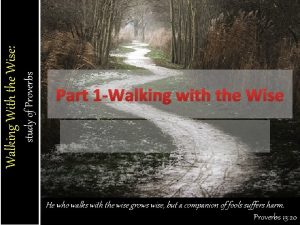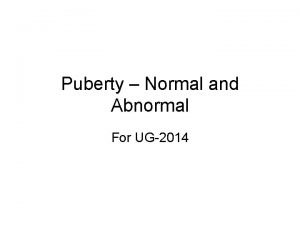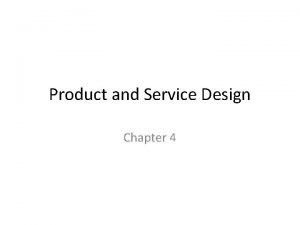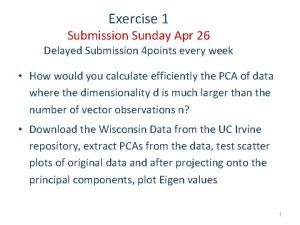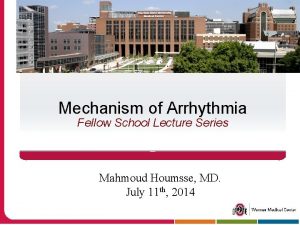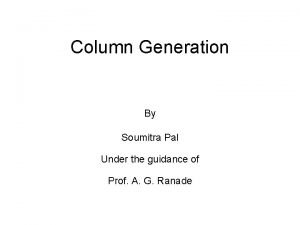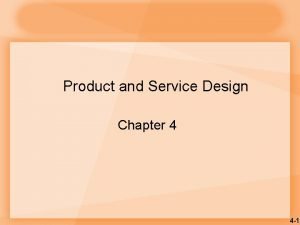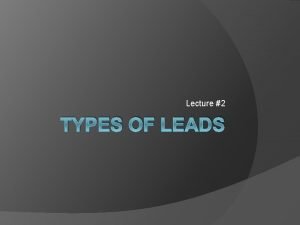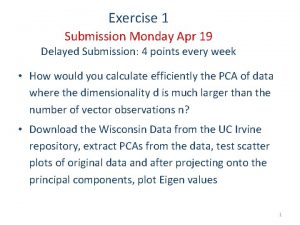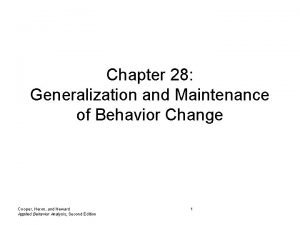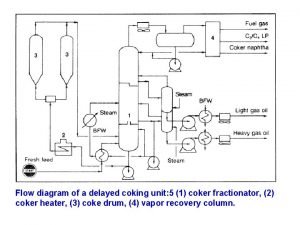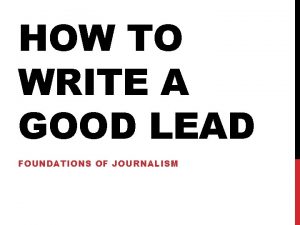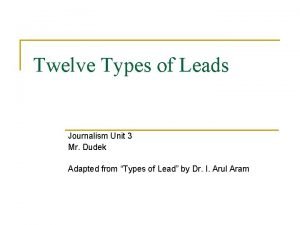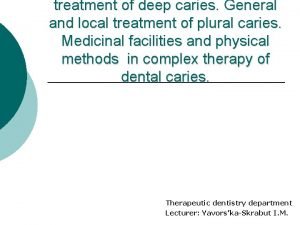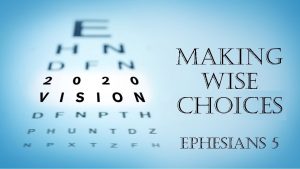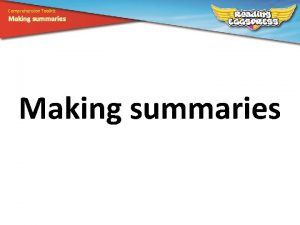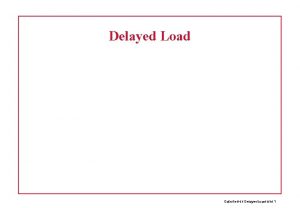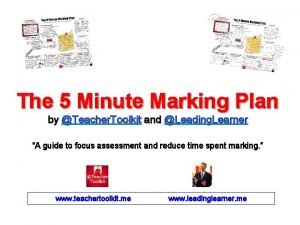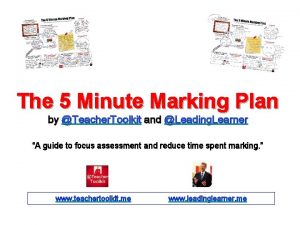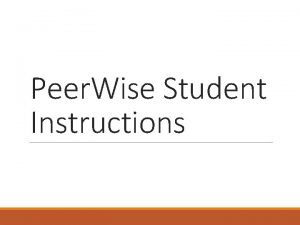Making Marking Wise Teacher Toolkit 1 Delayed Marking






























- Slides: 30

Making Marking Wise

@Teacher. Toolkit

• 1. Delayed Marking: • Student work is not given a grade, or score on the work (although the teacher records a grade in their teacher’s mark-book). Teacher written comments address quality of the work, and give guidance as to how to improve. Students need to be given time to read the comments in class to find out how they have achieved. After some time (e. g. one week) the teacher talks with some students individually to discuss the work, the teacher feedback, and the grade or mark that was given to it. Marking and Feedback 2016

• 2. Re-Drafting: • Get students to re-do a piece of work for you after a lesson focused on how to improve. Only accept the work if they have now scored a higher mark on it because they understand the feedback on how to improve. The Yellow Box is a useful methodology. Marking and Feedback 2016


• 3. Mastery Marking: • Only accept a piece of work when it is of a specific quality. You might only give one grade, an A. Students are expected to continue to re-draft and re-submit their work as many times as necessary in order to achieve an ‘A’ grade. Marking and Feedback 2016

• 4. Student Marking: • Get students to mark their own work, and their peers’ work, using student friendly mark-schemes. Marking and Feedback 2016

• 5. Colour Highlighting: • Students are given coloured pens and are expected to highlight on their work where they have shown evidence of different skills according to the requirements of the mark-scheme. Marking and Feedback 2016

• 6. Plus, Minus, Equals: • Mark student work in relation to previous work. If the latest work is of the same quality as the last, it receives an ‘=’ if it is better than the last it receives an ‘+’, and if it is not as good as the last it receives a ‘-‘. Marking and Feedback 2016

• 7. Focused Marking: • Mark student work against one or two specific criteria, even though there may be many criteria that could be marked. This allows the teacher to provide more focused and detailed feedback on things. The teacher’s markbook contains the skill marked rather than the title of the work set. Marking and Feedback 2016

• 8. Find and Fix: • Instead of marking answers as correct or incorrect, tell the students the number of answers that were wrong. Give them time in class to find and correct their mistakes either individually or in groups. Marking and Feedback 2016

• 9. Margin Marking: • Instead of marking each spelling or grammar mistake, put a mark in the margin for some of them for the students to find their own mistakes, and correct them. Marking and Feedback 2016

• 10. Traffic Lights: • Students are given a Red, Amber, or Green mark for a piece of work. All red or amber work can be re-drafted in an attempt to achieve a green mark. The final grade is calculated from the number of Green and Amber marks. • When using any marking strategy, don’t leave students with further queries. Why not try Praise, Suggestion, Question as an alternative strategy? Marking and Feedback 2016

In-house ideas

• • Well done, ……………. . !! You have worked very hard on this Unit and achieved level ……. . . You have demonstrated secure understanding why music needs structure. You can describe various forms of music including Call and Response, Binary form, Ternary form and Rondo. You can sing a call and response song confidently as part of the class. You performed confidently a piece of music in Binary and Ternary form You improvised different sections for your Rondo form You were leading your group in your performances You have completed the group and self evaluation and reflected on your and the whole group progress during this Unit. Targets for next Unit: q Transfer your performance skills into new Units q Attend instrumental lessons or the Waverley school choir q Keep up your positive behaviour and level of performance q Take a lead role in the organisation of a group performance • Unfortunately , ………………. . , you have not really made much effort during this Unit and have not made any significant progress. You have achieved level ……. • You have shown some understanding of how music is constructed • You can identify simple forms of music including Call and Response, Binary form, Ternary form and Rondo but your answers lack consistency • You can sing a call and response song as part of the class with some support and prompting • You performed a piece of music in Binary form with teacher’s support • You made attempts to improvised different sections for your Rondo form in a small group • You have completed the group and self evaluation and reflected on your and the whole group progress during this Unit. Targets for next Unit: q Build up your engagement in the lesson, focus and complete all the tasks q Attend instrumental lessons or the Waverley school choir to develop your confidence and performance skills q Keep the steady beat by counting to avoid timing issues q Avoid silly behaviours and any disruption • • Good Work, …………………. . . You have worked reasonably well on this Unit and achieved level ………. You have shown good understanding of how music is constructed You can identify and make comments on various forms of music including Call and Response, Binary form, Ternary form and Rondo. You can sing a call and response song as part of the class. You performed a piece of music in Binary and Ternary form with little support You improvised different sections for your Rondo form You have completed the group and self evaluation and reflected on your and the whole group progress during this Unit. Targets for next Unit: q Transfer your performance skills into the new Units q Attend instrumental lessons or the Waverley school choir to develop your confidence and performance skills q Keep the steady beat by counting to avoid timing issues q Avoid low level of disruption • Good Work, …………………. . . You have worked reasonably well on this Unit and achieved level ………. • You have shown good understanding of how music is constructed • You can identify and make comments on various forms of music including Call and Response, Binary form, Ternary form and Rondo. • You can sing a call and response song as part of the class. • You performed a piece of music in Binary and Ternary form with little support • You improvised different sections for your Rondo form • You have completed the group and self evaluation and reflected on your and the whole group progress during this Unit. Targets for next Unit: q Transfer your performance skills into the new Units q Attend instrumental lessons or the Waverley school choir to develop your confidence and performance skills q Keep the steady beat by counting to avoid timing issues

Good work!! Try to use the teacher’s drum loop as a basic example and develop your own ideas using R& B drum kit sounds. Miss Harding Good work!! Try to avoid timing issues in your drum loop. Keep steady beat on the bass drum. Beats 2 and 4 for snare drums/ claps. Miss Harding Good effort although you are still struggling to use all the features of Cubase correctly. Explore the use of Media. That will give you some ideas how to create a better drum loop. Miss Harding Unfortunately you have not made good progress. Improve your behaviour and attitude and focus on your work!! Miss Harding Excellent work!! You have achieved the target and now can move one level up!! Combine various layers of your composition. Miss Harding

Good work!! Try to choose a different sound for the melody line, eg: Violins for section 1/ celesta for section 2, organ for section 3 Miss Harding Good work!! Try to avoid timing issues when moving from one section to another. There should be no gaps. Miss Harding Good effort although you are still struggling to use all the Elements of music in full capacity. Explore the use of different timbres/ instruments. Experiment with the volume. Remember the piece should have the development> Eg from soft to loud, from thin texture to thick, etc. Miss Harding Unfortunately you have not made good progress. Improve your behaviour and attitude and focus on your work!! Miss Harding Excellent work!! You have achieved the target and now can move one level up!! Record your composition and prepare for the evaluation. Refer to the grading criteria when assessing yours and your friends’ works. Miss Harding Good work!! Try to choose a different sound for the melody line, eg: Violins for section 1/ celesta for section 2, organ for section 3 Miss Harding Good work!! Try to avoid timing issues when moving from one section to another. There should be no gaps. Miss Harding Good effort although you are still struggling to use all the Elements of music in fullcapacity. Explore the use of different timbres/ instruments. Experiment with the volume. Remember the piece should have the development> Eg from soft to loud, from thin texture to thick, etc. Miss Harding Unfortunately you have not made good progress. Improve your behaviour and attitude and focus on your work!! Miss Harding Excellent work!! You have achieved the target and now can move one level up!! Record your composition and prepare for the evaluation. Refer to the grading criteria when assessing yours and your friends’ works. Miss Harding Good work!! Try to choose a different sound for the melody line, eg: Violins for section 1/ celesta for section 2, organ for section 3 Miss Harding Good work!! Try to avoid timing issues when moving from one section to another. There should be no gaps. Miss Harding Good effort although you are still struggling to use all the Elements of music in full capacity. Explore the use of different timbres/ instruments. Experiment with the volume. Remember the piece should have the development> Eg from soft to loud, from thin texture to thick, etc. Miss Harding Unfortunately you have not made good progress. Improve your behaviour and attitude and focus on your work!! Miss Harding Excellent work!! You have achieved the target and now can move one level up!! Record your composition and prepare for the evaluation. Refer to the grading criteria when assessing yours and your friends’ works. Miss Harding

In the beginning In the middle In the end Pitch Timing Demonstrated features of African Music Class Performance “Sun Over Sahara” Djembe Drumming Self assessment: WWW: EBI: Grading Criteria • Limited pitch • Little awareness of the features • Many timing issues • Demonstrated various features • Various sounds • One or two timing issues • Demonstrated all the features • No timing issues • Confident use of the African drum

Evaluation What Went Well Even Better If Self Assessment We believe we achieved a Red Amber Green Level for our group composition and performance because we :

Group What features of African Music did you hear? Cyclic Rhythm Polyrhythm Call & Response Steady Pulse What challenge they presented if any? WWW: EBI: Level 1 2 3 4 5 Self assessment: African Djembe Compositions WWW: EBI: Grading Criteria • Limited pitch • Little awareness of the features • Many timing issues • No challenge presented • Demonstrated various features • Various sounds • One or two timing issues • Challenging part is present but has some timing/pitch issues • Demonstrated all the features • No timing issues • Challenging part is performed with accuracy and fluency • Confident use of the African drum

Date WWW EBI Target for next lesson (refer to criteria) Learning Journal Teacher comments

Sections Yellow Red Yellow Green Pitch /correct notes Timing Self assessment: WWW: EBI: Pop Song Final Assessment

My Target: : • • Autumn 2 Mozart 1 st Movement from Symphony 40 in G Minor Targets: I can describe the features of Classical music I can describe the differences between Baroque and Classical orchestra I can describe the Sonata form I can make comments on the 1 st movement from Symphony 40 in G minor describing: 1 st subject, 2 nd subject, exposition, development and recapitulation I can confidently describe melody, harmony and tonality, texture, structure and instrumentation of the 1 st movement from Symphony 40 in G minor I can identify correct instruments playing during different sections of the first movement from Symphony 40 in G minor I have marked my score of Symphony 40 in G minor and I am able to find musical features described in the above targets My Progress Teacher Pupil WWW: EBI: My WAG:

My Target: C • • Autumn 2 Mozart 1 st Movement from Symphony 40 in G Minor My WAG: B Performanc Targets: I can describe the features of Classical music e B-C I can describe the differences between Baroque and Classical orchestra I can describe the Sonata form I can make comments on the 1 st movement from Symphony 40 in G minor describing: 1 st subject, 2 nd subject, exposition, development and recapitulation I can confidently describe melody, harmony and tonality, texture, structure and instrumentation of the 1 st movement from Symphony 40 in G minor I can identify correct instruments playing during different sections of the first movement from Symphony 40 in G minor I have marked my score of Symphony 40 in G minor and I am able to find musical features described in the above targets My Progress Khan Rahil 90, 00 80, 00 70, 00 60, 00 50, 00 40, 00 30, 00 20, 00 10, 00 1 2 3 4 5 6 7 8 9 Khan Rahil 63, 64 28, 57 0, 00 81, 82 85, 71 42, 86 33, 33 76, 67 66, 67 Teacher WWW: 1. You have achieved Grade B for your Mock Exam Test. Well Done!!! 1. 2. You have kept your book very organised and neat 2. 3. You have been working very hard over this Unit 3. You have demonstrated amazing performance for your Performance Mock Exam. Keep it up!!! EBI: You have revised a bit more at home and achieved Grade A in your Mock Exam test. You were only 2 points away. Improve attendance. Pupil WWW: EBI:

WWW q You are able to identify instruments within the set works q You are able to identify different sections within different musical structures such as Recapitulation, Exposition, Development and Coda q You are able to identify Cadences q You are able to identify tonality q You have commented on musical elements using appropriate vocabulary such as “Slow” and “fast” for tempo. q You know wheat symbols on a score such as ped mean q You are aware that in Baroque music the Cello and Organ play a Continuo q You can describe how a melody line is put together or made clear q You can identify different types of voice q You are aware that Messiah comes from an Oratorio q You understand what a century is q You have written an effective Q 9 or 10 EBI q You were able to identify instruments within the set works q You were able to identify different sections within different musical structures such as Recapitulation, Exposition, Development and Coda q You were able to identify Cadences q You were able to identify tonality q You had commented on musical elements using appropriate vocabulary such as “Slow” and “fast” for tempo. q You knew wheat symbols on a score such as ped mean q You were aware that in Baroque music the Cello and Organ play a Continuo q You could describe how a melody line is put together or made clear q You could identify different types of voice q You were aware that Messiah comes from an Oratorio q You understood what a century is q You had written an effective Q 9 or 10 Pupil Comment

Date: Assessment 1 Title of Piece Criteria Teacher Comments: Developing musical ideas Demonstrating technical control Composing with musical coherence Student response: WWW: EBI: Grade Style To get a higher level you need:

Date: Assessment 1 Technique: Title of Piece Expression and Interpretation Composer Accuracy and Fluency: Instrument Total Raw Mark Total Mark (after scaling) Level of Difficulty Teacher Assessment: Grade Peer- Assessment: Lo. D: Technique: Expression and Interpretation: Accuracy and Fluency: Pupil’s Response: In this performance I …. My strong points were: To get a higher grade I will: To get a higher grade you need:



 He who walks with the wise grows wise
He who walks with the wise grows wise Once upon a time there lived an old woman
Once upon a time there lived an old woman Be wise in every decision you make
Be wise in every decision you make Delayed type hypersensitivity reactions
Delayed type hypersensitivity reactions Testicle size chart pictures
Testicle size chart pictures What does product and service design do
What does product and service design do Delayed submission
Delayed submission Multiple baseline across settings
Multiple baseline across settings Automatcity
Automatcity Blood transfusion complications
Blood transfusion complications Theme of great gatsby chapter 3
Theme of great gatsby chapter 3 Delayed column generation
Delayed column generation Delayed column generation
Delayed column generation Delayed type hypersensitivity reactions
Delayed type hypersensitivity reactions Delayed differentiation and modular design
Delayed differentiation and modular design Startling statement lead examples
Startling statement lead examples Approach to child with delayed walking
Approach to child with delayed walking Delayed submission
Delayed submission Disintegration definition tablet
Disintegration definition tablet Delayed green light
Delayed green light Dr sears delayed vaccine schedule 2021
Dr sears delayed vaccine schedule 2021 Indiscriminable contingencies
Indiscriminable contingencies Causes of delayed bone age
Causes of delayed bone age Pre carve and post carve burnishing
Pre carve and post carve burnishing Sip early offer
Sip early offer Delayed coker unit process+flow diagram
Delayed coker unit process+flow diagram Delayed offsides hockey
Delayed offsides hockey How to write a good lead
How to write a good lead Types of leads in newspaper
Types of leads in newspaper Bonded amalgam restoration slideshare
Bonded amalgam restoration slideshare Causes of delayed bone age
Causes of delayed bone age
